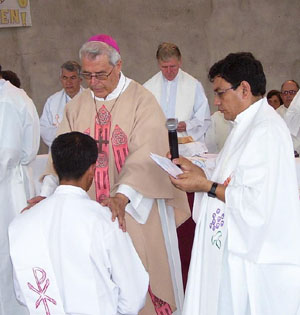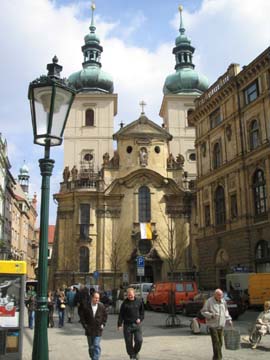|
no. 2 april - june 2006 The Carmelite Family in the "Titus Brandsma" General Delegation, Columbia The presence of Carmel in Colombia goes back many years. The devotion to Our Lady of Mount Carmel in the country preceded the first Carmelites. Midway in the last century, in 1954, the Carmelites of the Baetica Province (Spain) returned to Colombia and carried out an intensive missionary activity. In 1973, Bogota, Colombia was created as an international community for vocational activity throughout Latin America. With some ups and downs, the seed was beginning to germinate.
Thus the Delegation is growing and spreads, almost like the mustard seed. In the Assembly of 2004, the Prior General, Joseph Chalmers, gave a meditation on "Contemplation and Prayer" that provoked a discussion of more than an hour, with each person sharing their experience of prayer. It was a rich experience! The Italian Province also has a community on the coast of Colombia. (1) Ordination of Member of Titus Brandsma Delegation - Juan Evangelista Quiroga, was ordained on March 19, 2006, the feast of St. Joseph, in the Cathedral of Lago Agrio, Sucumbios, Equador by Bishop Gonzalo López Marañón, a Discalced Carmelite and long time friend of our community of Bogota.St. Albert of Sicily "Second Patron" The Madonna of Trapani Designated Patroness of the Diocese of Trapani Carmelite Pasquale Mariani, the prior of Trapani, has announced that the Vatican has designated the Madonna of Trapani as the Patroness of the Diocese and St. Albert of Sicily as the "Secondary Patron" of the Diocese. The statue of the Madonna of Trapani stands in the Carmelite church in the coastal city of Trapani. The Vatican’s decision was communicated in a letter to the Bishop of Trapani, Francesco Miccichè dated January 30, 2006 and signed by Bishop Mario Marini, the Undersecretary of the Congregation for Divine Worship and the Discipline of the Sacraments. The original decree was signed by Cardinal Francis Arinze, prefect of the Congregation. The Carmelite community in Trapani was one of about 15 houses in the major cities of Sicily and what is now Italy originally founded in the 13th century although the exact dates of these foundations are unknown. St. Albert entered the Carmelites through the community in Trapani. He died in 1307. The Madonna of Trapani is represented in a marble statue with the Christ Child in her arms. Both Mother and Child have slight smiles. Various stories about the statues origins are told. Copies of the statue are found throughout southern Europe, especially in Spain. The Viceroy of Sicily, an admirer of the Madonna, once commented "Whoever wishes to see her more beautiful form must go to heaven to see her."
The General Delegation of Bohemia et Moravia (Czech Delegation) has officially returned to the former Carmelite Church of San Gallus in the Old Town section in the center of Prague. Currently, members of the Delegation hold services in the church twice each week, traveling about 30 minutes from the Delegation’s house in the Liboc area of Prague. The church was constructed between 1300 and 1350 and was redone in the baroque style between 1704 and 1729. In 1626, the Polish Carmelite Sigismondo Gdowski obtained the parish church for the Order. To this day the interior of the church speaks of its heritage with a rich display of Carmelite painting, statues, and ornamental designs. In 1389 St. John Nepomucene became the pastor of St. Gallus for about one year. The 18 th century composer František Xaver Brixi made his living as an organist at the church.The original Carmelite foundation in Prague was in 1347 but was lost in the political and religious turmoil of the 16 th century in Bohemia. In 1781, the Emperor Franz Josef suppressed the province. In 1908 the Carmelites returned, residing at Kostelni Vydri. In 1949 all religious Orders were suppressed by the communist government although some of the Carmelites continued ministering in secret. They were joined by new members. On October 2, 1984, the General Council of the Order secretly created the General Delegation of Czechoslovakia. After the fall of communism in 1989, the Order began public ministry once again in the country.Today, the Czech Delegation has 19 members and, in addition to the houses in Liboc and Kostelni Vydri, has a house in Olomouc. There is a strong Lay Carmelite group with some 200 members from throughout the country. In addition, there is a monastery of Carmelite nuns in Ivancice and sisters of the Istituto di Nostra Signora del Carmelo minister in Stipa. A community of Donum Dei minister in Brno.
In the summer of 2002, four Carmelite nuns in the enclosed monastery in Duisburg set up a new monastery within the motherhouse of the Sisters of Mercy of St. Elisabeth. The Carmelites were given a portion of the top floor in an area, which is quite private with their own kitchen and dining area. They participate in liturgy with the other community but maintain their own monastic routine. The grounds provide them with a large secure area for walks and a pool for exercise. We are transferred! "We" are the Monastery of the Carmelite nuns of "Our Lady of Good Council" in Duisburg, Germany. We lived for more than 40 years in the heart of the city Duisburg is a port city, which was always alive—an industrial city with its problems that we were never able to be detached from and that continue. More and more frequently we asked ourselves, how an aging and always diminishing number of nuns could maintain a community in a monastery that was already too big for us without abandoning our essential work as Carmelite nuns. Should we wait until someone made the decision for us? Could we then continue to be together as a community? The visit of the auxiliary bishop of the diocese on the 20th of March 2002 presented us the possibility of discussing our situation. He showed us understanding and he suggested that we make contact with the motherhouse of the Sisters of Mercy of St. Elisabeth in Bredney, near Essen. His assistance allowed us to have a meeting within a short period of time and the General Council of the sisters was so welcoming. The decision was clear: our monastery was moving! Mother Heriburgis, the prioress of the community of the sisters, gave us her idea: "If the towns can work together, why should not the houses of religious!" On July 24, 2002, the move happened but a departure and a new beginning take time. To us it meant to have the space to get used to the changes and to the new arrangements. Also in these moments the warmth and generosity of the community of the sisters in the motherhouse have been an enormous help. It has been possible to follow our Carmelite routine without any interruption and we have been enriched by the experience of the spirituality of the community in the motherhouse. Address: Monastery of the Carmelite Nuns / "Our Lady of Good Council" / Schuirweg 107 / 45133 Essen, Germany (1) Carmelite nuns Carmelita, Teresita, Angela, and Baptista in Essen gather around a young visitor with a laptop to see some of the Carmelite resources on the interenet (CITOC foto) |
|
RETURN TO THE INDEX FOR 2006 | RETURN TO THE INDEX FOR THIS ISSUE INDEX OF CARMELITE
WEBSITES |

 It was in 1986 that the Titus Brandsma General Delegation was erected.
In the 80 some years of the missionary work of the Carmelites, many
Pequenos Carmelos (small Carmels) are beginning to appear. These are
small communities of lay people who feel attracted by Carmelite
spirituality in their search to live the Gospel of Jesus as well as to
have hope during this difficult period Colombia is enduring. To some, the
Pequenos Carmelos were the beginning of a life process with four
phases, each with its celebrations, symbols, prayers, observances, and
regular practices. The first step begins with the reception of the
Scapular. In the second step, one receives the Bible and a rosary, which
is the Bible of the poor. In the third step, one received the cross. In
the fourth, one receives the Carmelite shield as an expression of final
commitment. The first and fourth steps are always celebrated in January,
during the Annual Assembly, in the presence of representatives of all the
Pequenos Carmelos. In 2006, six mothers of families made their
final commitment as Carmelites and received the shield of Carmel as a sign
of their commitment. Two years before, during the celebration of the
Annual Assembly, 19 people received the Scapular, two received the Bible,
and one received the cross, four received the shield and the daughter of
one couple was baptized.
It was in 1986 that the Titus Brandsma General Delegation was erected.
In the 80 some years of the missionary work of the Carmelites, many
Pequenos Carmelos (small Carmels) are beginning to appear. These are
small communities of lay people who feel attracted by Carmelite
spirituality in their search to live the Gospel of Jesus as well as to
have hope during this difficult period Colombia is enduring. To some, the
Pequenos Carmelos were the beginning of a life process with four
phases, each with its celebrations, symbols, prayers, observances, and
regular practices. The first step begins with the reception of the
Scapular. In the second step, one receives the Bible and a rosary, which
is the Bible of the poor. In the third step, one received the cross. In
the fourth, one receives the Carmelite shield as an expression of final
commitment. The first and fourth steps are always celebrated in January,
during the Annual Assembly, in the presence of representatives of all the
Pequenos Carmelos. In 2006, six mothers of families made their
final commitment as Carmelites and received the shield of Carmel as a sign
of their commitment. Two years before, during the celebration of the
Annual Assembly, 19 people received the Scapular, two received the Bible,
and one received the cross, four received the shield and the daughter of
one couple was baptized.
